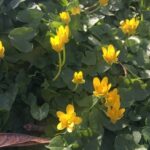Designing the Wild
The most common colors for native flowers are white, yellow and purple, and if you intend to recreate the look of a wild meadow, this is the color scheme you should keep in mind.
Meadows don’t display apparent hierarchies of height or color; their overall look is that of a flat, colorful, and uniform tapestry. Their feral plants are fierce in defending themselves from dangers with thorns, traps, and active compounds that irritate the skin. Between the thistle scratches, the nettle welts, and the long winding snares of vetches, a wild meadow is meant to be seen, not experienced up close.
Its dwellers’ inner mechanisms quietly guide their development, in such a way that the meadow never looks the same from one year to the next. Each season a new species is given the stage to shine, and the other plants keep a low profile, waiting for their turn in the limelight in the future.
It’s hard to replicate such a sophisticated large-scale coordination.
The closest the gardener can come to it is to keep reseeding the lot for a few years until the native plants naturalize and their collective entity, the meadow itself, reaches a mature balance.




 Previous Post
Previous Post Next Post
Next Post




